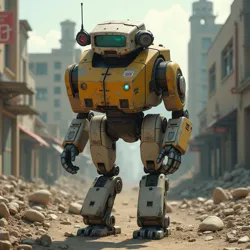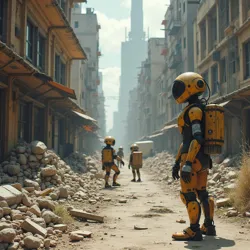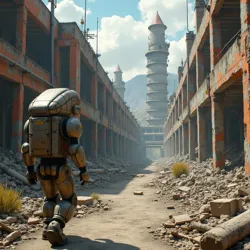The Great Post-Apocalyptic AI-Powered Scavenger Hunt for Survival
 An autonomous scavenging unit, nicknamed "Rustbucket," searches through the remnants of a pre-collapse shopping center in the Eastern Deadlands
An autonomous scavenging unit, nicknamed "Rustbucket," searches through the remnants of a pre-collapse shopping center in the Eastern DeadlandsIn the aftermath of the Great Systems Collapse of 2157, humanity found itself scattered across a drastically altered landscape, struggling to survive amidst the ruins of their former civilization. What emerged from this chaos was an unprecedented fusion of desperation and technological innovation: The Great Post-Apocalyptic AI-Powered Scavenger Hunt for Survival, commonly known as "The Hunt." This ongoing phenomenon represents humanity's creative adaptation to catastrophic circumstances, combining artificial intelligence, survival instincts, and community cooperation in ways never before imagined.
Origins and Development
The Hunt began as a grassroots initiative in the New Providence Settlement when survivors discovered that many pre-collapse AI systems had survived in isolated pockets, primarily in hardened data centers and autonomous maintenance facilities. Dr. Sarah Chen-Martinez, a former robotics engineer, first proposed reprogramming these systems to assist in locating crucial survival resources. What started as a local experiment quickly spread across the remaining settlements as its effectiveness became apparent.
The integration of surviving AI systems with human survival needs proved transformative. The AIs, originally designed for tasks ranging from inventory management to urban planning, were modified to process vast amounts of pre-collapse data and identify likely locations of essential supplies. This marriage of human intuition and machine learning capabilities created a sophisticated resource-location network that has become essential to post-collapse society.
Methodology and Implementation
The Hunt operates through a complex network of Autonomous Resource Scouts (ARS) working in conjunction with human scavenging teams. These AI-powered units utilize advanced algorithms to analyze satellite imagery, pre-collapse infrastructure maps, and real-time environmental data to identify potential resource caches. The system employs Adaptive Prediction Matrices to account for post-collapse changes in the landscape and the likelihood of previous scavenging activities.
 Scavenger teams reviewing AI-generated probability maps before embarking on a coordinated resource expedition
Scavenger teams reviewing AI-generated probability maps before embarking on a coordinated resource expeditionHuman teams work alongside their AI counterparts, providing crucial ground-level decision-making and the ability to navigate unexpected obstacles. The Scavenger's Code, a comprehensive set of protocols developed by the Wasteland Council, governs these expeditions, ensuring fair resource distribution and minimal conflict between competing groups.
Resource Classification System
The Hunt employs a sophisticated classification system for discovered resources, categorizing them based on both immediate survival value and potential for long-term reconstruction efforts. The primary categories include:
-
Essential Survival Resources (ESR): Medicine, clean water sources, preserved food
-
Technological Recovery Items (TRI): Functioning electronics, power cells, communication equipment
-
Infrastructure Components (IC): Building materials, tools, mechanical parts
Social Impact and Cultural Significance
The Hunt has evolved beyond its practical origins to become a cornerstone of post-collapse culture. Communities celebrate successful hunts with Gathering Festivals, where resources are distributed and stories are shared. The Guild of AI Interpreters has emerged as a respected social class, with members skilled in maintaining and communicating with the AI systems that make the Hunt possible.
In the Coastal Territories, the Hunt has given rise to a unique form of art known as Resource Poetry, where scavengers compose elaborate verses about their experiences and discoveries. These poems often incorporate AI-generated probability matrices into their structure, creating a distinctive fusion of human creativity and machine logic.
Technological Evolution
As the Hunt has matured, the technology supporting it has undergone significant evolution. The development of Quantum Memory Crystals has allowed for more efficient storage and processing of scavenging data, while Bioneural Interface Systems have improved the synchronization between human intuition and AI analytical capabilities.
The recent integration of Atmospheric Analysis Drones has expanded the Hunt's capabilities, allowing teams to detect resources through changes in air composition and thermal signatures. This advancement has been particularly crucial in identifying underground bunkers and sealed storage facilities that might otherwise have remained hidden.
Challenges and Controversies
Despite its success, the Hunt faces ongoing challenges. The Resource Ethics Committee regularly debates issues surrounding the fair distribution of discovered supplies and the potential dangers of over-reliance on AI guidance. Some communities, particularly the Naturalist Enclaves, resist participation in the Hunt, arguing for the development of self-sufficient living practices instead.
The phenomenon of Cache Piracy has emerged as a serious concern, with rogue groups attempting to intercept hunting teams or hack into AI systems to gain advantage. The Wasteland Peacekeepers have developed increasingly sophisticated methods to combat these threats, including the deployment of AI-powered security drones.
Future Prospects
As humanity continues to adapt to its post-collapse reality, the Hunt evolves alongside it. Current developments focus on integrating Biorecognition Technology to improve the identification of useful biological resources and the implementation of Predictive Restoration Mapping to support rebuilding efforts. The Institute of Tomorrow predicts that the Hunt will play a crucial role in humanity's gradual recovery, potentially leading to the establishment of a new form of civilization that more harmoniously balances human and artificial intelligence.
 The New Haven Community Center, rebuilt using resources and materials located through AI-guided hunting expeditions
The New Haven Community Center, rebuilt using resources and materials located through AI-guided hunting expeditionsThe Great Post-Apocalyptic AI-Powered Scavenger Hunt for Survival stands as a testament to human adaptability and the potential for technology to serve as a bridge between past and future. As communities continue to rebuild and evolve, the Hunt remains an essential tool for survival and a symbol of hope for a recovering world.
See also
- The Synthetic Companion Protocol
- Post-Collapse Resource Management
- AI Conservation Initiative
- Wasteland Navigation Systems
References
The article draws from numerous survivor accounts, AI logs, and community records maintained by the Global Archives of Post-Collapse History. Additional information has been compiled from the Technical Database of Restored Knowledge and the Oral Histories of the New Age.